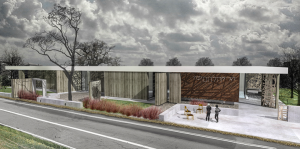CULTURE Villa Emma, Remembrance through Art
Several dozens of architectural design projects from different Italian, European and non-European cities have been submitted to build a monument in memory of the Jewish boys who were offered protection at Villa Emma, in Nonantola, in the province of Modena, between the summer of 1942 and the spring of 1943. Participants in the competition were very numerous and distinguished themselves for the quality of their works.
The Studio Bianchini e Lusiardi Associati eventually won the competition, coming up with a design that is based on both a physical and symbolic thickening of the paths and the human relationships that involved 73 youths who found shelter in the Emilian municipality and were given help to reach Switzerland after the 8th of September. Their artistic itinerary is marked by little chairs, “the ultimate symbol of welcoming and hospitality, made up of bronze and placed near some of the key places of the story”.
The competition “Davanti a Villa Emma” ended this way and the last few days were dedicated to the award ceremony and to the opening of an exhibition showing all the competing projects. Participants included representatives of local and regional institutions, the Director of the Villa Emma Foundation Fausto Ciuffi, the UCEI President Noemi Di Segni, the CDEC Foundation President Gadi Luzzato Voghera and Adachiara Zevi as chair of the judging panel.
After six years of hard work, research, meetings and seminars, a contest was held, and a winner was eventually chosen. These have been the various steps that have led to the latest events, with meetings and interim reports of an activity which “is going to be put into practice, discussing with representatives of the institutions, coworkers and protagonists of the architectural designs what remains to be done and what will be the path that will lead right to the front door of Villa Emma”.
“It was a great challenge”, Zevi has said. “In times like these, when there is a strong tendency towards the preservation of historical memory and many examples of memorial architectures and works of art are produced, and I am thinking of Carpi’s Monument Museum to the Political and Racial Deportee or the Museum for the Memory of Ustica in Bologna and Ferrara’s Meis, coming up with a design capable of giving a special and fairly complex story such an original shape and space was far from obvious”.
The winning design was Riccardo Bianchini and Federica Lusiardi’s “non-building”. “And by ‘non-building’ we mean three different things: there are no clear boundaries limiting the building, and as a consequence the transparency of the covering makes it permeable to the surrounding countryside; the massive use of wood as construction material, the reference to the sukkah as the prototype of temporary shelter, and above all the dynamism of the structural elements, the panels holding up the documentation that are built in such a way as to turn along the trajectories pointing at the places the boys came from and arrived in”.
“Under the big covering, partly opaque and transparent, the architecture – crossed by the same trajectories – splits up in the central part, some wall sections move, some others turn following the directions of near and far places, thus resulting in a hybrid and undefined boundary. It is a structure that, thanks to its lightness and adaptability, perfectly mirrors the discretion of the people of Nonantola, whose memory of the event has changed over time: after integrating it within the framework of Resistance, they ended up marginalizing it, maybe because they did not want it to become the sole symbol of their identity”.
*Translated by Arianna Mercuriali, student at the Advanced School for Interpreters and Translators of Trieste University, intern at the newspaper office of the Union of the Italian Jewish Communities.

